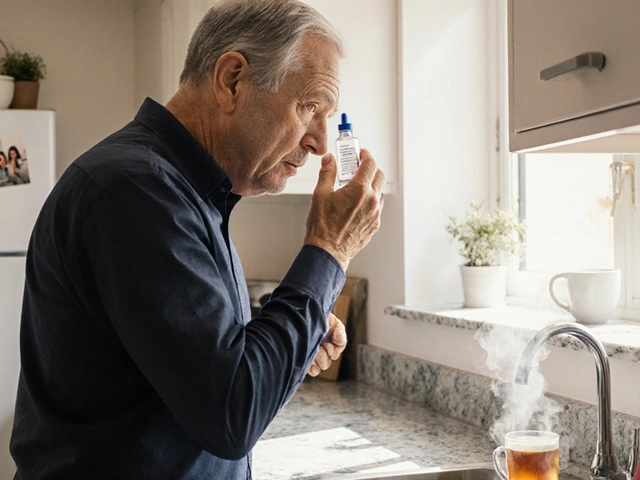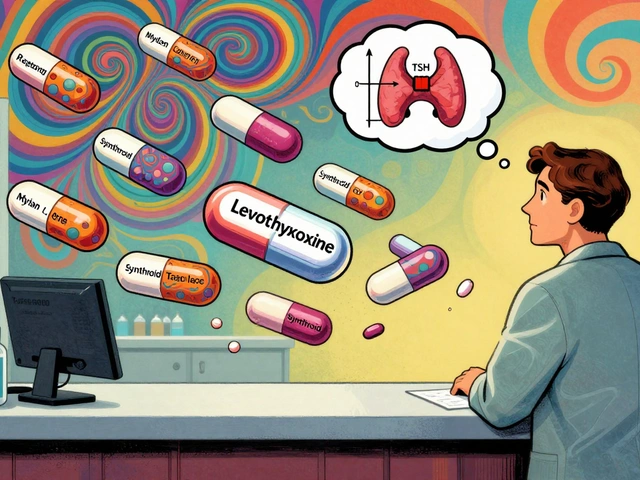
When your throat suddenly feels like sandpaper and your fever spikes without warning, it’s easy to assume it’s just a cold. But if you’ve got a sore throat with no cough, swollen tonsils with white patches, and swollen neck glands, you might be dealing with something more serious: strep throat. This isn’t just a bad sore throat-it’s a bacterial infection caused by Group A Streptococcus, and it needs the right treatment to avoid serious complications.
How Do You Know It’s Strep Throat and Not a Virus?
Most sore throats are viral. You get them with a runny nose, cough, hoarseness, or red eyes. Strep throat is different. It hits fast and hard, and it doesn’t come with those typical cold symptoms. In fact, if you have a cough or runny nose, it’s very unlikely to be strep. The classic signs are clear:- Sudden, severe throat pain
- Fever above 100.4°F (38°C)
- Tender, swollen lymph nodes in the neck
- White patches or pus on the tonsils
- Small red spots on the roof of the mouth (palatal petechiae)
- No cough, no runny nose, no sneezing
How Is Strep Throat Actually Diagnosed?
You can’t tell for sure just by looking. That’s why testing matters. There are three main tests used in clinics today. The rapid antigen test (RADT) gives results in 10 to 30 minutes. It’s fast, accurate, and widely used. But it’s not perfect. About 5-15% of the time, it misses strep-especially in kids under 5, where bacterial load is lower. That’s why, if the test is negative and the patient is a child or teen, doctors often follow up with a throat culture. The throat culture is the gold standard. A swab is sent to a lab and grown in a petri dish. Results take 18 to 48 hours, but it catches nearly all cases that the rapid test misses. It’s slow, but reliable. Now, there’s a newer option: molecular testing (PCR). It’s even more sensitive than culture-catching 95-98% of cases-and gives results in 24 to 48 hours. It’s becoming more common in urgent care centers and hospitals, especially since a new FDA-approved test called Strep Ultra hit the market in March 2024 with 98% sensitivity and results in just 15 minutes. The CDC recommends testing all symptomatic patients, especially kids. For adults with low risk (Centor score under 3) and a negative rapid test, testing might not be needed. But for children, skipping a follow-up culture after a negative rapid test can be dangerous.Which Antibiotics Work Best for Strep Throat?
Antibiotics aren’t just for feeling better faster-they’re critical to prevent complications. Left untreated, about 3% of strep cases can lead to rheumatic fever, a serious condition that can damage heart valves. That’s why treatment isn’t optional. The first-line treatment is still penicillin V or amoxicillin. Both are cheap, effective, and safe. Adults take 500 mg twice daily for 10 days. Kids get doses based on weight: 250 mg twice daily, or amoxicillin at 50 mg/kg once a day (up to 1,000 mg). These drugs clear the bacteria in 95% of cases when taken fully. If you’re allergic to penicillin, options include:- Cephalexin (a cephalosporin): 20 mg/kg twice daily, up to 500 mg per dose
- Clindamycin: 7 mg/kg three times daily, up to 300 mg per dose
- Azithromycin: 12 mg/kg once daily for 5 days, up to 500 mg

What Happens After You Start Antibiotics?
You’ll feel better fast-but not because antibiotics are magic. They kill the bacteria, and your immune system does the rest. Most people notice improvement within 24 to 48 hours. Fever drops, swallowing gets easier, and energy returns. But here’s the catch: you’re still contagious until you’ve been on antibiotics for at least 24 hours. That means:- Stay home from school or work for the first full day of treatment
- Avoid close contact with others, especially young children and elderly people
- Don’t share utensils, drinks, or toothbrushes
Recovery Timeline: What to Expect Day by Day
Here’s what a typical recovery looks like with proper treatment:- Day 1: Symptoms peak-severe throat pain, fever, fatigue. Start antibiotics.
- Day 2: Fever begins to drop. Throat pain eases slightly. You’re no longer contagious after 24 hours of antibiotics.
- Day 3-4: Significant improvement. Swallowing is easier. Energy returns.
- Day 5-7: Most symptoms gone. Tonsils may still look slightly swollen, but no pus or fever.
- Day 8-10: Full recovery. Finish antibiotics. No lingering pain or fever.
When Should You Worry? Signs of Complications
Most people recover without issue. But if symptoms don’t improve after 48 hours of antibiotics-or if they get worse-you need to see a doctor. Red flags include:- Fever returning after it was gone
- Difficulty breathing or swallowing
- Swelling in the neck or jaw
- Severe headache or stiff neck
- Rash (could be scarlet fever)
- Pain on one side of the throat only (possible peritonsillar abscess)

Common Mistakes People Make
Even with clear guidelines, mistakes are common-and costly.- Stopping antibiotics early: 40% of parents stop when symptoms improve. That increases relapse risk and helps bacteria become resistant.
- Using leftover antibiotics: 12% of adults admit to using old prescriptions. Wrong dose, wrong drug, wrong illness-this fuels resistance.
- Sharing antibiotics: 8% of adults on Reddit reported giving their meds to family members. Don’t do it. Dosing is weight-based. What works for you could harm someone else.
- Asking for antibiotics for viral sore throats: The CDC says 30% of outpatient antibiotic prescriptions are unnecessary. Each misuse chips away at our ability to treat future infections.
What’s New in Strep Throat Treatment?
The field is evolving. The new Strep Ultra test is changing the game-faster, more accurate, and now being rolled out in urgent care clinics. By 2026, 40% of these centers may use point-of-care PCR testing, making diagnosis almost instant. Researchers are also testing whether a 5-day antibiotic course could be as effective as 10 days. Early results from a multi-center trial (NCT05678901) suggest it might be-but we won’t know for sure until mid-2025. And yes, scientists are still trying to make a vaccine. But Group A Streptococcus has over 200 different strains, each with a slightly different surface protein. That’s why a vaccine has been so hard to develop. For now, antibiotics remain our best tool.Final Thoughts: Don’t Guess, Test, Treat, Finish
Strep throat is common, but it’s not trivial. It’s not just about feeling better-it’s about preventing lifelong heart damage. The solution is simple: test when symptoms point to strep, treat with the right antibiotic, and finish the full course. Don’t rely on home remedies or hope it goes away. Don’t pressure your doctor for antibiotics if you have a cough. And don’t save leftover pills for next time. Your body-and the community’s health-depends on using these tools wisely.Can you get strep throat without a fever?
It’s rare. Fever above 100.4°F (38°C) is one of the key signs of strep throat, present in about 85% of confirmed cases. If you have a sore throat but no fever, it’s more likely viral. However, some adults-especially older or immunocompromised individuals-may not spike a fever even with strep. If other symptoms match (no cough, swollen glands, white tonsils), testing is still recommended.
Is strep throat contagious after 24 hours of antibiotics?
No. Once you’ve taken antibiotics for 24 hours, you’re no longer contagious. This is why health guidelines say you can return to school or work after a full day of treatment-as long as your fever is gone and you’re feeling better. Before that, you can easily spread the bacteria through coughing, sneezing, or sharing drinks.
Can you have strep throat and test negative?
Yes. Rapid antigen tests miss about 5-15% of cases, especially in young children who have lower bacterial loads. If a child or teen has strong symptoms but a negative rapid test, a throat culture is still needed to rule out strep. Adults with low risk scores and negative tests may not need further testing, but children should always be confirmed with culture if clinical suspicion is high.
Why do you need to take antibiotics for 10 days if you feel better in 2 days?
Feeling better doesn’t mean the bacteria are gone. Strep throat can return in 5-15% of cases if treatment is stopped early. More importantly, incomplete treatment raises the risk of rheumatic fever, a serious condition that can damage your heart valves. The 10-day course ensures every last bacterium is wiped out. Even if you feel fine, finish the pills.
Are there natural remedies that cure strep throat?
No. Honey, salt water gargles, and herbal teas can soothe throat pain, but they don’t kill the bacteria causing strep. Only antibiotics can prevent complications like rheumatic fever or abscesses. Relying on natural remedies alone puts you at risk. If you suspect strep, get tested and treat it with the right medicine.
Can adults get strep throat as often as kids?
No. Children aged 3 to 9 are most at risk, with 15-30% of their sore throats caused by strep. In adults, it’s much rarer-only 5-15% of sore throats are bacterial. Adults are more likely to have viral infections. But when adults do get strep, the risk of complications is still real, so testing and treatment are just as important.
What’s the cheapest antibiotic for strep throat?
Penicillin V is the most affordable option, often costing less than $4 for a full 10-day course at most U.S. pharmacies. Amoxicillin is also inexpensive, usually under $10. More expensive options like azithromycin can cost up to $250 if not covered by insurance. Always ask for the generic version-it’s just as effective and far cheaper.
Can you get strep throat more than once?
Yes. Having strep once doesn’t give you lifelong immunity. You can get it again, especially if you’re exposed to someone carrying the bacteria. Some people are carriers-meaning they have the bacteria in their throat without symptoms-and can spread it without knowing. Good hygiene and completing your antibiotic course reduce your risk of repeat infections.






Sam Jepsen
November 25, 2025 AT 10:37Yvonne Franklin
November 25, 2025 AT 10:39Bartholemy Tuite
November 26, 2025 AT 08:52Neoma Geoghegan
November 27, 2025 AT 20:40Jeff Hicken
November 29, 2025 AT 13:31Victoria Stanley
November 30, 2025 AT 19:53Rachael Gallagher
December 2, 2025 AT 02:31steven patiño palacio
December 3, 2025 AT 13:22stephanie Hill
December 5, 2025 AT 12:36Akash Chopda
December 5, 2025 AT 15:46Nikki C
December 6, 2025 AT 12:45Alex Dubrovin
December 7, 2025 AT 11:05